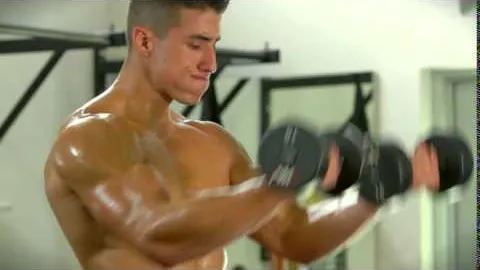
When it comes to achieving a well-rounded and sculpted physique, it's important not to neglect any muscle group. One area that often gets overlooked is the shoulders, despite playing a crucial role in both aesthetics and functional movements. Regularly incorporating exercises that target the shoulders into your workout routine is essential for building strength, stability, and definition in this muscle group.
One exercise that can effectively target the shoulders is the dumbbell reverse front raise. This exercise primarily engages the posterior deltoids, but also recruits the anterior deltoids, trapezius, and other supporting muscles. In addition to working the shoulders, it also helps improve posture and upper body stability.
Initial Position: Begin by selecting a pair of dumbbells that are appropriate for your strength level. Stand with your feet shoulder-width apart, and hold the dumbbells at your sides with your palms facing your body. This is the starting position.
Execution: Keeping your back straight and core engaged, slowly lift the dumbbells straight out in front of you, away from your body. To target the rear deltoids effectively, ensure that your thumbs are pointing down, and your palms are facing the floor throughout the movement. Pause momentarily at the top, ensuring that your arms are parallel to the floor.
Return: Lower the dumbbells back down to the starting position in a controlled manner. Repeat the exercise for the desired number of repetitions.
Seated Dumbbell Reverse Front Raise: By performing this exercise seated on a bench, you eliminate the potential for lower body involvement, ensuring a more isolated shoulder workout.
Unilateral Dumbbell Reverse Front Raise: Instead of raising both arms simultaneously, perform the exercise one arm at a time to further focus on each shoulder individually.
Resistance Band Reverse Front Raise: If you don't have access to dumbbells, you can also perform this exercise using a resistance band. Simply step onto the middle of the band, and hold the ends with each hand. Lift the band in the same motion as described earlier.
As with any exercise, it's important to prioritize safety to prevent injury. Here are a few safety considerations to keep in mind when performing the dumbbell reverse front raise:
Avoid using excessive weight, especially when first starting with this exercise. Proper form and technique should always take precedence over the amount of weight lifted.
Do not forcefully swing your arms or use momentum to lift the weights. This can place excessive stress on the shoulder joints and reduce the effectiveness of the exercise.
If you have a history of shoulder problems or any pre-existing shoulder injuries, it's advisable to consult with a healthcare professional before incorporating this exercise into your routine.
The dumbbell reverse front raise is an effective exercise for targeting the shoulders, particularly the posterior deltoids. By incorporating this exercise into your routine regularly, you can improve shoulder strength, stability, and definition. Remember to start with proper form, gradually increase the weight over time, and prioritize safety to maximize your results and reduce the risk of injury. So, grab those dumbbells and get ready to take your shoulders to the next level!
If you're looking for a gym, fitness club or yoga studio, you've come to the right place.
You can find information about gyms in your area. Browse catalog of gyms and find gyms with classes which are you looking for.
On gym page you can find simple information like address, phone or website. You can find list of available classes. You can check availability of personal training or small group classes. On place page you can also see information about open hours.
You can find gyms near you with amenities, courts, studios and equipments.
Use our map to find gym at your city or district.
In Gym Navigator you can find list of exercises with movies for many body parts.
You can browse exercises catalog and find exercises the best of you.
You can also find exercises grouped into workout plans, which you can use to improve you body. Each routine show you exercises one by one and give you possibility to count you progress and count down rest time.